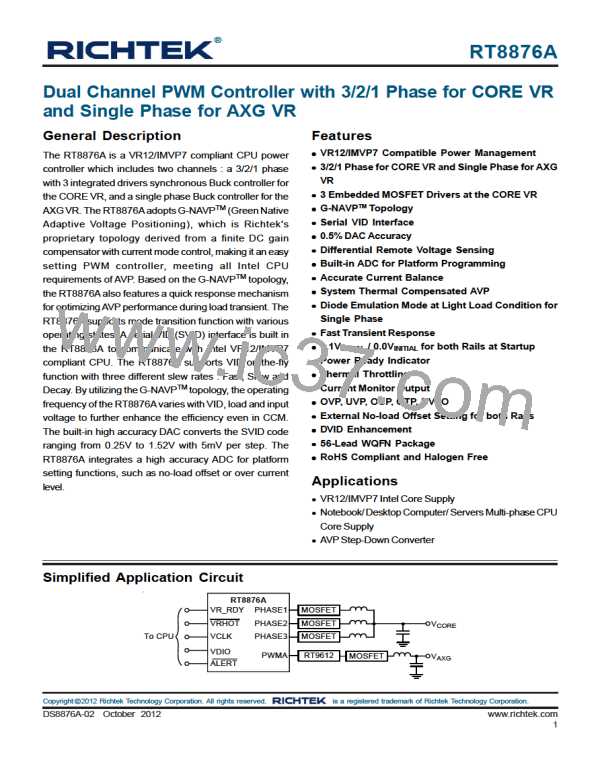RT8876A
are lower and the controller is powered from a lower voltage
supply. Low frequency operation offers the best overall
efficiency at the expense of component size and board
space. Figure 21 shows the on-time setting circuit.
Connect a resistor (RTON) between VIN,AXG and TONSETA
pin to set the on-time of UGATE :
R
R1
C1
TON
TONSETA
V
CCRCOT
On-Time
Computer
IN, AXG
V
DAC, AXG
On-Time
Figure 21. AXG VR : On-Time setting with RC Filter
24.4×10−12 ×RTON
(45)
tON (VDAC < 1.2V) =
VIN − VDAC,AXG
Differential Remote Sense Setting
where tON is the UGATE turn-on period, VIN is the input
voltage of theAXGVR, and VDAC, AXG is theDAC voltage.
When VDAC,AXG is larger than 1.2V, the equivalent switching
frequency may be too fast at over 500kHz, which is
unacceptable. Therefore, theAXGVR implements a pseudo
constant frequency technology to avoid this disadvantage
of CCRCOT topology. When VDAC,AXG is larger than 1.2V,
the on-time equation will be modified to :
TheAXGVR includes differential, remote sense inputs to
eliminate the effects of voltage drops along the PC board
traces, CPU internal power routes and socket contacts.
The CPU contains on-die sense pins VCCAXG_SENSE and
VSSAXG_SENSE. Connect the RGNDA to VSSAXG_SENSE
.
Connect the FBA to VCCAXG_SENSE with a resistor to build
the negative input path of the error amplifier. The VDAC,AXG
and the precision voltage reference are referred to RGNDA
for accurate remote sensing.
20.33×10−12 ×RTON × VDAC, AXG
tON (VDAC ≥ 1.2V) =
VIN − VDAC, AXG
(46)
Current Sense Setting
On-time translates only roughly to switching frequencies.
The on-times guaranteed in the Electrical Characteristics
are influenced by switching delays in the external HS-
FET. Also, the dead-time effect increases the effective
on-time, which in turn reduces the switching frequency. It
occurs only in CCM, and during dynamic output voltage
transitions when the inductor current reverses at light or
negative load currents. With reversed inductor current,
the phase goes high earlier than normal, extending the
on-time by a period equal to the HS-FET rising dead time.
The current sense topology of the AXGVR is continuous
inductor current sensing. Therefore, the controller can be
less noise sensitive. Low offset amplifiers are used for
loop control and over current detection. The internal current
sense amplifier gain (AI) is fixed to be 20. The ISENAP
and ISENANdenote the positive and negative input of the
current sense amplifier. Users can either use a current
sense resistor or the inductor's DCR for current sensing.
Using inductor's DCR allows higher efficiency as shown
in Figure 22. Refer to below equation for optimum transient
performance :
For better efficiency of the given load range, the maximum
L
DCR
(48)
= R × C
switching frequency is suggested to be :
X
X
1
For example, choosing L = 0.36μH with 1mΩDCR and CX
= 100nF yields :
fS(MAX)(kHz) =
×
tON − THS−Delay
⎡
⎤
VDAC(MAX) +ILOAD(MAX) × RON_LS−FET + DCR − RDROOP
0.36μH
1m Ω×1 0 0n F
⎣
⎦
R
=
= 3.6kΩ
(49)
X
⎡ ⎤
+ILOAD(MAX) × RON_LS−FET −RON_HS−FET
V
IN(MAX)
⎣
⎦
V
(47)
OUT, AXG
where fS(MAX) is the maximum switching frequency, tHS-
L
DCR
is the turn-on delay of HS-FET, VDAC(MAX) is the
DELAY
C
X
R
X
maximum VDAC,AXG of application, VIN(MAX) is the maximum
application input voltage, ILOAD(MAX) is the maximum load
+ V
-
X
ISENAP
ISENAN
of application, RON_LS-FET is the Low side FET RDS(ON)
,
RON_HS-FET is the High side FET RDS(ON), DCR is the
inductor DCR, and RDROOP is the load line setting.
Figure 22. AXG VR : Lossless Inductor Sensing
Copyright 2012 Richtek Technology Corporation. All rights reserved.
©
is a registered trademark of Richtek Technology Corporation.
www.richtek.com
42
DS8876A-02 October 2012

 RICHTEK [ RICHTEK TECHNOLOGY CORPORATION ]
RICHTEK [ RICHTEK TECHNOLOGY CORPORATION ]